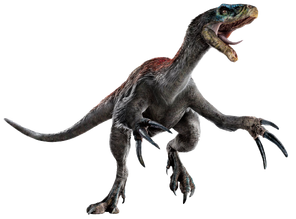Therizinosaurus cheloniformis (meaning "scythe reptile") is an extinct genus of therizinosaurid theropod dinosaur that lived in Mongolia during the Late Cretaceous period.
It could grow up to 10 meters (33 feet) long and reach 5 tonnes in weight. Therizinosaurus lived in the late Cretaceous Period (late Campanian-early Maastrichtian stages, around 70 million years ago), and was one of the last and largest representatives of its unique group, the Therizinosauria ('reaping lizards'). It is known only from a few bones, including gigantic hand claws, from which it gets its name. Also, studies have shown that the Therizinosaurs were actually Maniraptorans (not weird sauropods like they were thought to be when they were first discovered), due to the hip alignment of the creatures.

Anatomy[]
Therizinosaurus had a small head with a beaked mouth, atop a long neck. It was bipedal and had a large, heavy, deep body, as evidenced by the wide pelvis, 2.5 meter (8 foot) long arms and legs that ended in four toes (three of which supported the animal's weight), which were tipped by short, curved claws. The most distinctive feature of the animal was the presence of three gigantic claws on its front limbs. Each of the three digits of its hand bore these claws, which reached nearly a meter (approximately 3.3 feet) in length. The largest claw was on the first digit. The feeding habits of Therizinosaurus are still debated, but it was most probably an herbivore, using its big claws to push leaves into its mouth.Other hypotheses suggest that it was a termite eater, using its claws to open large termite nests - but it seems highly unlikely that an animal the size of Therizinosaurus could survive on a diet based on insects and features of the skull (including a beaked mouth and flattened teeth) suggest a herbivorous diet. Based off of much research and data collected, it is found that this species had a strange addiction to plants. There are other possible functions that could have been served by the claws of Therizinosaurus, such as defense against predators (e.g. the contemporary Tarbosaurus) and in intraspecific fighting, such as fighting for territory or for mating.It also seems as though they used their claws to eat plants and fruits.
It is highly likely that Therizinosaurus was feathered, given that its close relative Beipiaosaurus certainly was.
Therizinosaurus is ancient greek for Reaping Lizard, reffering to the large, curved claws of the fore limb.The only and type species is Therizinosaurus cheloniformus, meaning Turtle Shaped Reaping Lizard, reffering to the fact that the claws were originally thought to belong to an extinct giant turtle.
Discovery and Species[]
The first fossils now attributed to Therizinosaurus were discovered in the late 1940s by a joint Soviet-Mongolian fossil expedition. The expedition unearthed several giant claws that measured up to a meter in length. However, it was not known what creature these belonged to until the early 1950s, when further fossil expeditions unearthed more bones: several more sets of claws and parts of a forelimb and hindlimb. Subsequent finds in northern China allowed paleontologists to assemble the general skeletal structure of the animal, which was determined to be a dinosaur and not a turtle.
The recent discovery of several related dinosaurs - Alxasaurus in 1994 and Beipiaosaurus in 1999 - helped clarify the position of the therizinosaurs as a whole. Various theories had been proposed to explain the ancestry of these dinosaurs, with some scientists even suggesting they were descendents of (info needed) - but these new, well-preserved finds, giving details about the bird-like pelvis, feet and skulls, helped confirm that the therizinosaurs were all maniraptoran, theropod dinosaurs.
Trivia[]
When the first fossils of the Therizinosaurus were found, they mistakingly identified as the skeleton of a giant turtle.
No one has ever found a full skeleton, and the only known bones are of its arms and legs.
In Popular Culture[]

- Therizinosaurus appeared in the BBC Walking With Dinosaurs special "Chased By Dinosaurs".
- Therizinosaurus appears in the PlayStation video game Dino Crisis. In the game, Therizinosaurus is portrayed as an active predator rather than a herbivore.
- Therizinosaurus appeared on Dinosaur King in episode 28 and 49.
- Therizinosaurus was seen in Dinosaur Hunting: The Lost Continent, where two Therizinosaurus became the main target to rescue in Stage 9.
- Therizinosaurus was seen on The Lost World: Jurassic Park Sega Gear game, it was seen depicted as a burrowing dinosaurs which was located in the Baryonyx Area.

Therizinosaurus as portrayed in Walking with Dinosaurs